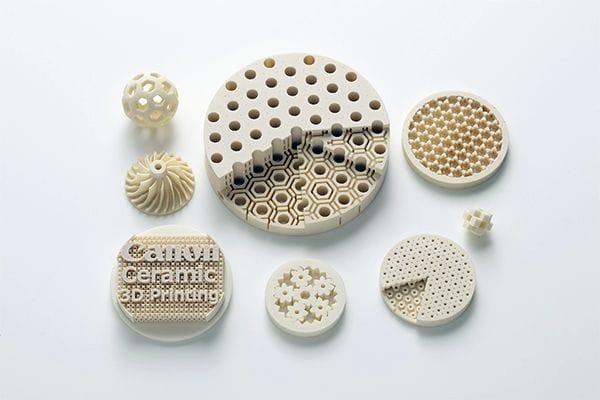![3D printed ceramic parts [Source: Canon]](https://fabbaloo.com/wp-content/uploads/2020/05/image-asset_img_5eb0a18ea0eec.jpg)
Japanese giant Canon announced new ceramic 3D printer materials.
Wait, you didn’t know that Canon produces 3D printers? Indeed they do, and you will find they focus on the industrial market. Even though the company is best known for its consumer goods, Canon produces a large amount of large-scale industrial gear. One of their product lines is 3D printers.
Specifically, the Canon equipment uses a stereolithography process, in which a photopolymer is selectively solidified by a laser. This is essentially the SLA process as used in many other 3D printing systems.
Stereolithography is one of the 3D printing processes that is relatively easy to scale up to large sizes: you simply increase the size of the reservoir holding the photopolymer and extend the range of the laser by adapting mirror systems. That size alone makes the process suitable for industrial use.
Up to now Canon has produced polymer parts from their system, but recently the company stepped into ceramics. They explain:
“Canon has developed a new alumina-based ceramic material suited to selective laser melting as well as a new parts production technology. Through this technology, a 3D printer can be used to stably produce ceramic parts with such complex geometries as hollow and porous structures, which are difficult to achieve through ordinary metal molding or cutting processes.”
So it would appear they have added a new process to their existing SLA-style equipment that is similar to, as they say, SLM. This is most likely a powder-bed / laser system very similar to what is done in SLS systems.
However, there is a post-processing step required, as the ceramic material must undergo an annealing process to finalize the part. In other systems this step does introduce problems because the parts tend to shrink as the binder is removed from the part. This leads to challenges with the parts’ dimensional accuracy.
![Test 3D print showing the capabilities of a new ceramic material [Source: Canon]](https://fabbaloo.com/wp-content/uploads/2020/05/canon-ceramic-print_result_img_5eb0a18ef2612.jpg)
However, Canon explains that in one of their tests a 19mm part was produced with an “accuracy drift” of only 0.8%, or 1.5mm.
It also appears that the new material is usable only in the new, unnamed Canon equipment. They explain:
”Canon Inc. announced today that the company has developed a manufacturing technology for the highly accurate 3D printing of ceramic parts with complex geometries using a proprietary ceramic material for 3D printers.”
Their announcement is rather mysterious as they don’t mention the name of the new process, the name of the machine or even the name of the line of machines. They also did not announce availability dates or pricing.
I suppose we must wait for further details to learn more.
Via Canon











Tritone has been quietly building their MoldJet technology and is nearing a release of their beta 3D printing equipment.